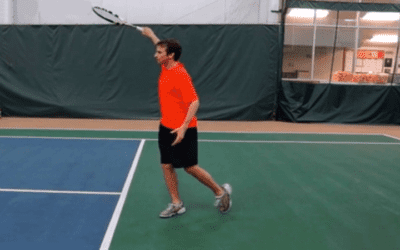How To Master Your Tennis Backhand Slice Technique
Did you know that the tennis backhand slice is one of the most misunderstood shots in tennis? In this tennis article, I will share a simple technique tip to easily fix a common mistake made on the backhand slice. As a result, you will be able to hit your tennis backhand slice like the pros.
Most club coaches teaching the one-handed backhand slice focus heavily on the follow through in tennis. For example, you may have even heard the phrase “separate your hands” before. This refers to both hands abducting away from the body on the follow through.
One of the biggest problems I see with tennis backhand slice technique is exaggerated hand separation. While the non-dominant hand should move away, it should not be at a 90 degree angle away from the body. In summary, if you want to improve and master your backhand slice, follow my simple tip in this blog.
Tennis Backhand Slice Common Mistake

Let’s discuss the tennis backhand slice. One of the best technique tips to help your slice is focus on what your non-dominant hand does. Traditional coaches will teach you to separate your arms on your follow through in tennis.
When you watch the pros, even top players like Novak Djokovic separate their arms. I know some will argue this point, but I think Djokovic’s backhand slice could improve if he made this change that I’m about to reveal.
If you want to master your backhand slice, keep your non-dominant arm and hand closer to your body on the follow through. I’m not saying to keep your arms glued together. I simply think the arms should not separate quite as much as they are typically taught.
On a one-handed backhand slice, the non-dominant arm should extend slightly. Your arm should not extend so much that it looks like you’re showing off your arm span. To clarify, the non-dominant arm should not come forward. Instead, I prefer for the non-dominant arm to extend slightly back while staying close to the body for the follow through in tennis.
Tennis Backhand Slice Technique
One of the primary steps to master a tennis backhand slice is to have a good feel for the ball. The feel of the tennis ball on the racquet should be prioritized over the power. This is why I teach keeping the non-dominant hand closer to the body.
In my experience, when players focus on hand separation during the follow through in tennis, there is a loss of feel and connection to the ball. With proper tennis backhand slice technique, you get a better feel for the ball.
During a backhand slice, the path of the racquet should primarily come across your body. In fact, I believe this racquet path should be prioritized over reaching far out in front for the ball. The wrist should be firm and maintain a neutral position during the follow through for a better finish. Similar to the non-dominant hand follow through, the swing path will have a better feel for the ball.
Ultimately, this helps your body stay more connected throughout the shot. If you study the technique of other one-handed backhand shots, like the backhand drop shot, you will discover that the follow through in tennis is extremely important. For example, when hitting a backhand drop shot, holding the follow through can improve the quality of the whole stroke.
Bonus Tips: Tennis Backhand Slice Footwork & Follow Through

Here are a couple of bonus tips to take your tennis backhand slice to the next level. You may have heard the term “chip and charge” before. This refers to a very common strategy, where a tennis player uses a slice as their approach shot. In other words, “chip” refers to the slice and “charge” refers to the approach. This is a great play, but too often I see players using incorrect footwork while approaching the net.
If I’m being picky about backhand slice technique, I see too many players keep their weight on their inside front foot while approaching the net. This takes your momentum to the outside of the court, away from your ideal recovery position at net. In actuality, the better play is to hit the slice approach shot off of the outside foot. This way of hitting encourages a proper recovery back toward the center of the court. If you would like to learn more, check out my video for some more footwork tips on the tennis backhand slice approach shot.
Conclusion

One of the most misunderstood aspects of the backhand slice is the follow through in tennis. Too many players and coaches put unnecessary emphasis on separating the hands. Unfortunately, this focus often leads to a low quality backhand slice and an overall disconnected stroke.
The good news is, there is an easy fix. Still focus on the follow through, but keep the non-dominant hand in closer to your body for a more accurate stroke. The follow through in tennis is a common narrative. If you pay attention to the technique of the follow through, you will be on your way to mastering the backhand slice.
By Jeff Salzenstein, Founder Tennis Evolution
Jeff is a former top 100 ATP player and USTA high performance coach committed to helping players and coaches all over the world improve” at the end of the blog.
P.S. – Want to take your topspin forehand to the next level? Discover the 3 amateur mistakes that could be killing your tennis forehand potential, click here to get instant access.
10 Comments
Submit a Comment
You must be logged in to post a comment.


Hi Jeff,
Appreciate your posts and great videos!
Can you please explain why a lot of the top pros separate their offhand?
SlowMo of Fed : http://www.youtube.com/watch?v=OHPdlGW4vEE
SlowMo of Fed,Wawrinka,& Youzny: http://www.youtube.com/watch?v=II7Wo0y6fC8
Is your instruction targeted towards intermediate players, or also advanced?
I’m a 5.5 and find myself not separating, but wish I did separate more often as when I do I find I gain both spin and pace (at the expense of time and simplicity) and really make my slice ‘bite’.
Cheers,
Ignac
This tip I give applies to all levels. I think some pros separate too much but you have to find a style that works best for you.
Thanks Jeff,
This example is clearly of a very defensive slice. Would you say the same thing applies to a more offensive slice?
Brian, This is for all slices
Jeff-
why? you don’t give any explanation of why this is better.
correct me if I am wrong but the off arm goes backward to stop rotation so you don’t turn through the slice backhand. The ‘equal and opposite’ arm action stops upper body rotation and releases the racquet arm forward.
Additionally, part of the forward motion of the racquet arm is accomplished with the traps (trapezius muscles) contracting and squeezing the shoulder blades together. Upper back muscles play a major role in the one-handed backhand.
If so, why is a non-symmetric motionn preferrable to a symmetric contraction of the upper back muscles?
this is not at all clear to me.
I feel the body stays more “connected”when the off arm does not separate as much.
Jeff,
Does the same concept apply to a one handed topspin shot as well? It seems like Federer’s off hand practically wraps around his neck on this shot!
The concept is similar on the one handed topspin backhand. The off arm should not fly back so much unless it works for you.
Hi Jeff,
Many thanks for the video tips, I find them most helpful.
Can you please advise the correct grip for one handed slice backhand and one handed topspin backhand?
HI Danielle, I prefer a “weak” continental on the slice and easter/semi western backhand grip on the one handed topspin backhand